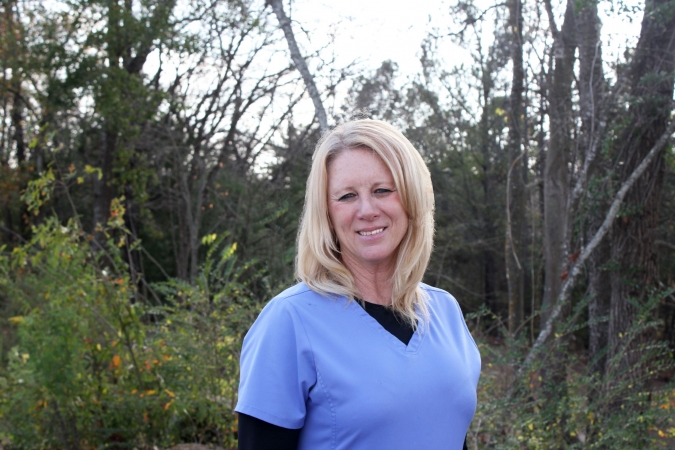
Patricia Porter doesn’t miss a beat. As an EKG technician at UT Health Tyler, she performs tests that are used to monitor a patient’s heart rate. She can often help detect heart disease, heart attack, an enlarged heart or abnormal heart rhythms that may cause heart failure in the future.
However, there was one heart attack she could not help to predict – her own.
To be fair, there were no warning signs. As a healthy and active 56-year-old, Patricia had no personal or family history of heart disease and no pre-existing conditions that may have increased her risks. She had no reason to worry.
But one evening after dinner, she was out on a walk with her boyfriend. She began to feel very tired and out of breath; this was unusual as this walk was a regular part of her routine.
“It’s like all of a sudden my energy level dropped,” Patricia said. “It was not normal.”
Cutting the walk short, they turned back to the house, and she thought nothing more about it. After all, she was probably tired from her busy day-to-day routine.
But the following week when she arrived at work, she began feeling poorly again. She clocked out of work around 10 a.m. and called her doctor to schedule an appointment for that afternoon. She was about to head home to change into more comfortable clothes, but while walking out to her car, a crushing chest pain stopped her in her tracks.
“It was like a cement truck full of cement hit me in the chest,” Patricia said. “It was so painful.”
Luckily, Francisco Rivera, APRN, MSN, FNP-C, a nurse practitioner, was outside the hospital at the same time. He noticed Patricia standing on the sidewalk holding her chest and asked if she was OK. “No, I don’t think I am,” Patricia answered.
Francisco quickly realized the seriousness of the situation and helped her back into a waiting area. He coded for help, and she was quickly checked into the emergency room.
Patricia knew how lucky she was to have received such immediate care. “What a beautiful blessing it is that I work at the hospital. If I had gotten in my car that day, I probably wouldn’t be here now.”
Augustine Njoku, MD, FACC, FSCAI, interventional cardiologist with Tyler Cardiovascular Consultants, noted how the short amount of time between symptom onset to treatment might have made the difference with her treatment outcome. “For patients who experience a heart attack, a quick response time and efficient care are critical to a positive outcome. We will call this concept ‘Time is Tissue’- meaning that fast, comprehensive care from a physician can result in less damage to the heart.” he said.
After being admitted and taken to the cath lab, it was confirmed Patricia had a complete blockage of her left anterior descending artery (LAD), which was causing an acute myocardial infarction (STEMI). This type of heart attack affects the electrical current in the lower chambers of the heart and has a particularly high risk for complications or even death.
“In her presentation of acute myocardial infarction (STEMI) a coronary stenting procedure with a drug-coated stent to relieve the acute blockage was the appropriate and safest option to restore flow immediately in the blocked artery,” Dr. Njoku said.
Patricia was taken to the UT Health East Texas Heart and Vascular Institute in Tyler where Dr. Njoku performed the minimally invasive stenting procedure. “He saved my life,” she said.
After the successful procedure, Patricia was transferred to the Cardiovascular Intensive Care Unit (CVICU) at UT Health Tyler to recover. There, she was finally able to process what happened. In the rush of the moment, she hadn’t been able to tell her family what was happening.
One of her co-workers, Zachary Prewitt, heard she was in the hospital and stopped by to check on her. “He was one of the first people to come check on me and asked how I was doing and if I needed to call my family members. And he was able to call my boyfriend for me.”
After being transferred to a less-acute level of care, Patricia was discharged a couple of days later. “I just wanted to make sure to recognize those guys, they were just amazing,” Patricia said.
Now Patricia is focused on the long road to recovery and hopes to do cardiac rehabilitation to help get her back to her normal pace of life. “They said it would take me about six months to get my energy level back up. But sometimes our bodies tell us to slow down and our minds don’t. This was my red flag to slow down.”
Now, taking more time to stop and focus on her health, she wants others to do the same.
“I’ve always been a go-getter. I try to stay on top of my duties and get things done. But I do need to think about what I eat and how I do things. It’s not always about getting the work done, it’s also about my health. I need to be able to take care of myself in order to take care of others.”
She goes on to offer this advice. “If you have chest pains or you get out of breath easily, get it checked out. Don’t put it off.”
Early detection of cardiovascular disease can help prevent future heart attacks and strokes. If you are concerned about your cardiovascular health or have a family history of heart disease or stroke, UT Health East Texas offers a convenient and affordable diagnostic heart screening program. MyHeart First bundles together the seven screenings proven to most accurately detect heart disease and defects.
Visit UTHealthEastTexas.com/myheart-first for more information about the program.
